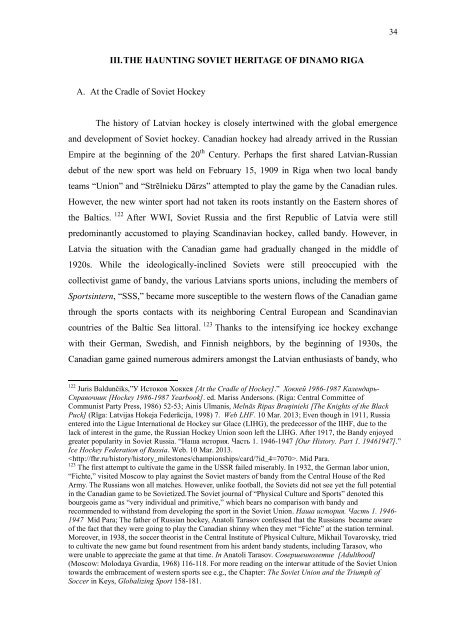University of Turku Faculty of Humanities Baltic Sea Region ... - Doria
University of Turku Faculty of Humanities Baltic Sea Region ... - Doria
University of Turku Faculty of Humanities Baltic Sea Region ... - Doria
You also want an ePaper? Increase the reach of your titles
YUMPU automatically turns print PDFs into web optimized ePapers that Google loves.
34<br />
III. THE HAUNTING SOVIET HERITAGE OF DINAMO RIGA<br />
A. At the Cradle <strong>of</strong> Soviet Hockey<br />
The history <strong>of</strong> Latvian hockey is closely intertwined with the global emergence<br />
and development <strong>of</strong> Soviet hockey. Canadian hockey had already arrived in the Russian<br />
Empire at the beginning <strong>of</strong> the 20 th Century. Perhaps the first shared Latvian-Russian<br />
debut <strong>of</strong> the new sport was held on February 15, 1909 in Riga when two local bandy<br />
teams “Union” and “Strēlnieku Dārzs” attempted to play the game by the Canadian rules.<br />
However, the new winter sport had not taken its roots instantly on the Eastern shores <strong>of</strong><br />
the <strong>Baltic</strong>s. 122 After WWI, Soviet Russia and the first Republic <strong>of</strong> Latvia were still<br />
predominantly accustomed to playing Scandinavian hockey, called bandy. However, in<br />
Latvia the situation with the Canadian game had gradually changed in the middle <strong>of</strong><br />
1920s. While the ideologically-inclined Soviets were still preoccupied with the<br />
collectivist game <strong>of</strong> bandy, the various Latvians sports unions, including the members <strong>of</strong><br />
Sportsintern, “SSS,” became more susceptible to the western flows <strong>of</strong> the Canadian game<br />
through the sports contacts with its neighboring Central European and Scandinavian<br />
countries <strong>of</strong> the <strong>Baltic</strong> <strong>Sea</strong> littoral. 123 Thanks to the intensifying ice hockey exchange<br />
with their German, Swedish, and Finnish neighbors, by the beginning <strong>of</strong> 1930s, the<br />
Canadian game gained numerous admirers amongst the Latvian enthusiasts <strong>of</strong> bandy, who<br />
122 Juris Baldunčiks,”У Истоков Хоккея [At the Cradle <strong>of</strong> Hockey].” Хоккей 1986-1987 Календарь-<br />
Справочник [Hockey 1986-1987 Yearbook]. ed. Mariss Andersons. (Riga: Central Committee <strong>of</strong><br />
Communist Party Press, 1986) 52-53; Ainis Ulmanis, Melnās Ripas Bruņinieki [The Knights <strong>of</strong> the Black<br />
Puck] (Rīga: Latvijas Hokeja Federācija, 1998) 7. Web LHF. 10 Mar. 2013; Even though in 1911, Russia<br />
entered into the Ligue International de Hockey sur Glace (LIHG), the predecessor <strong>of</strong> the IIHF, due to the<br />
lack <strong>of</strong> interest in the game, the Russian Hockey Union soon left the LIHG. After 1917, the Bandy enjoyed<br />
greater popularity in Soviet Russia. “Наша история. Часть 1. 1946-1947 [Our History. Part 1. 19461947].”<br />
Ice Hockey Federation <strong>of</strong> Russia. Web. 10 Mar. 2013.<br />
. Mid Para.<br />
123 The first attempt to cultivate the game in the USSR failed miserably. In 1932, the German labor union,<br />
“Fichte,” visited Moscow to play against the Soviet masters <strong>of</strong> bandy from the Central House <strong>of</strong> the Red<br />
Army. The Russians won all matches. However, unlike football, the Soviets did not see yet the full potential<br />
in the Canadian game to be Sovietized.The Soviet journal <strong>of</strong> “Physical Culture and Sports” denoted this<br />
bourgeois game as “very individual and primitive,” which bears no comparison with bandy and<br />
recommended to withstand from developing the sport in the Soviet Union. Наша история. Часть 1. 1946-<br />
1947 Mid Para; The father <strong>of</strong> Russian hockey, Anatoli Tarasov confessed that the Russians became aware<br />
<strong>of</strong> the fact that they were going to play the Canadian shinny when they met “Fichte” at the station terminal.<br />
Moreover, in 1938, the soccer theorist in the Central Institute <strong>of</strong> Physical Culture, Mikhail Tovarovsky, tried<br />
to cultivate the new game but found resentment from his ardent bandy students, including Tarasov, who<br />
were unable to appreciate the game at that time. In Anatoli Tarasov. Совершеннолетие [Adulthood]<br />
(Moscow: Molodaya Gvardia, 1968) 116-118. For more reading on the interwar attitude <strong>of</strong> the Soviet Union<br />
towards the embracement <strong>of</strong> western sports see e.g., the Chapter: The Soviet Union and the Triumph <strong>of</strong><br />
Soccer in Keys, Globalizing Sport 158-181.
















